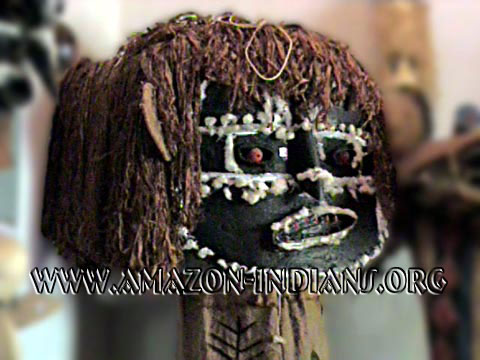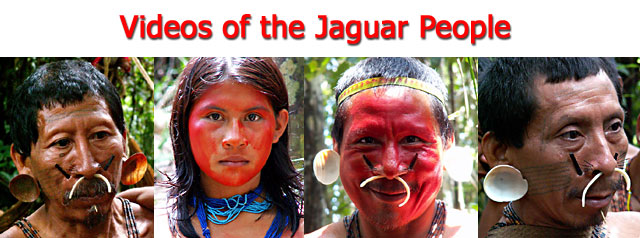|
any cultures practice special ceremonies that mark
the transition from childhood to adulthood. For many indigenous Amazonian
tribes, these ceremonies take on special significance in that they enable the
society to pass on their unique customs and knowledge from one generation to
another, thus preserving an important part of the culture.
The Ticuna (also spelled Tikuna or Tukuna) Indians of Peru, Colombia, and Brazil practice a ceremony called
“Pelazon” (in Spanish) or “Moça Nova” (in Portuguese). I was fortunate enough to
have witnessed this ceremony when I hiked into an isolated Ticuna village on the
border of Colombia and Peru. The four-day ceremony is only practiced during a
full-moon and I was lucky to have had visited the Ticunas at that time. After a
strenuous four-hour hike that began at six o’clock in the morning, I arrived at
the village. Immediately, I went to the residence of the “Curaca” or chief of
the village. The Curaca informed me that I was the first foreigner who
had ever hiked into t he
village. He was a very gracious individual who invited me into his home and
explained that I had arrived at a very fortuitous moment in that a Pelazon
was taking place in the village at that very moment. Never having heard of the
ceremony, I inquired as to its significance. The Curaca explained that
when a girl has her first menstrual cycle, she is placed into isolation in a
small room and no one (other than several older women whose job it is to educate
her) is allowed to visit the girl. During her isolation, she is taught about the
myths, heroes, and history of the Ticunas. In addition, she is taught about her
future responsibilities as an adult member of the tribe. This period of
isolation varies, but can last up to six months, after which the Pelazon
ceremony commences. he
village. He was a very gracious individual who invited me into his home and
explained that I had arrived at a very fortuitous moment in that a Pelazon
was taking place in the village at that very moment. Never having heard of the
ceremony, I inquired as to its significance. The Curaca explained that
when a girl has her first menstrual cycle, she is placed into isolation in a
small room and no one (other than several older women whose job it is to educate
her) is allowed to visit the girl. During her isolation, she is taught about the
myths, heroes, and history of the Ticunas. In addition, she is taught about her
future responsibilities as an adult member of the tribe. This period of
isolation varies, but can last up to six months, after which the Pelazon
ceremony commences.
One feature that characterizes the ceremony is the use of the black dye obtained
from fruit of the “huito” tree (Genipa americana). The entire body of the
girl is painted black with huito and the symbol of her clan is painted on
her face, and interestingly girls are not permitted to intermarry within their
own clan. All her hair is removed. Formerly, they would actually pull out the
hair out by hand, but currently the process is often less painful and scissors
are sometimes used. But for the Ticun a
girls that take part in this rite of passage, the pulling of the hair is not the
most difficult part of the ceremony. Rather, enduring four days of the ceremony
without being allowed to sleep is the most challenging aspect of the ceremony
for the girls. During the ceremony, Ticuna girls are dressed with eagle feathers
and wear a crown that is initially used to cover her eyes preventing her from
seeing. Snail shells (which represent fertility) are hung from her belt as this
ceremony is not only a rite of passage but a ceremony of fertility. For four
long days the girls endure a rather loud ceremony with constant music (primarily
drum-beating) singing, dancing, and purification by fire. Yes, fire! The
purification consists of having the girls continuously jump over a campfire.
Some participants wear huge masks which represent mythological beings and
danger. The girls dance with the masked beings which symbolizes her
metamorphosis into adulthood and her ability to successfully deal with the
dangers of being an adult. a
girls that take part in this rite of passage, the pulling of the hair is not the
most difficult part of the ceremony. Rather, enduring four days of the ceremony
without being allowed to sleep is the most challenging aspect of the ceremony
for the girls. During the ceremony, Ticuna girls are dressed with eagle feathers
and wear a crown that is initially used to cover her eyes preventing her from
seeing. Snail shells (which represent fertility) are hung from her belt as this
ceremony is not only a rite of passage but a ceremony of fertility. For four
long days the girls endure a rather loud ceremony with constant music (primarily
drum-beating) singing, dancing, and purification by fire. Yes, fire! The
purification consists of having the girls continuously jump over a campfire.
Some participants wear huge masks which represent mythological beings and
danger. The girls dance with the masked beings which symbolizes her
metamorphosis into adulthood and her ability to successfully deal with the
dangers of being an adult.
 While
the ceremony begins with the Ticuna girl leaving isolation, it ends with the
girl being carried with a baby to a lake or river. There both she and the infant
are placed into the water, representing sym-bolically a final cleansing before
she is allowed to wear adult clothes and to enter the world of adulthood. While
the ceremony begins with the Ticuna girl leaving isolation, it ends with the
girl being carried with a baby to a lake or river. There both she and the infant
are placed into the water, representing sym-bolically a final cleansing before
she is allowed to wear adult clothes and to enter the world of adulthood.
Since my first encounter that full-moon with the Ticunas, I have learned much
about their rich and beautiful culture. Curiously, the Ticuna language is
totally unique being unrelated to any other spoken language, analogous to the
Basque language of Spain and France which is unrelated to all known languages.
Later, I met Don Humberto, a Peruvian Ticuna who is perhaps the most
knowledgeable medicine man in the entire Amazon. I owe much of my knowledge of
medicinal plants to the famous Don Humberto who graciously spent much time
teaching me the ways of the Ticunas.
If you would like to learn how you can meet the
Ticuna Indians and find out how you can help them preserve their culture, please contact
me at
djpantone@amazon-indians.org.
For more information about Amazon Indians, please
visit
www.amazon-indians.org/matis. Videos of my expeditions with the Ticuna and
Matis Indians are
available on DVD and instant download.
The author, Dr. Dan James Pantone, is the editor
of Amazon-Indians and the founder of the Movement in the Amazon for Tribal
Subsistence and Economic Sustainability,
a non-profit association that is helping
indigenous Amazonians
so that they themselves can sustain their culture
traditionally and independently.
|




 he
village. He was a very gracious individual who invited me into his home and
explained that I had arrived at a very fortuitous moment in that a Pelazon
was taking place in the village at that very moment. Never having heard of the
ceremony, I inquired as to its significance. The Curaca explained that
when a girl has her first menstrual cycle, she is placed into isolation in a
small room and no one (other than several older women whose job it is to educate
her) is allowed to visit the girl. During her isolation, she is taught about the
myths, heroes, and history of the Ticunas. In addition, she is taught about her
future responsibilities as an adult member of the tribe. This period of
isolation varies, but can last up to six months, after which the Pelazon
ceremony commences.
he
village. He was a very gracious individual who invited me into his home and
explained that I had arrived at a very fortuitous moment in that a Pelazon
was taking place in the village at that very moment. Never having heard of the
ceremony, I inquired as to its significance. The Curaca explained that
when a girl has her first menstrual cycle, she is placed into isolation in a
small room and no one (other than several older women whose job it is to educate
her) is allowed to visit the girl. During her isolation, she is taught about the
myths, heroes, and history of the Ticunas. In addition, she is taught about her
future responsibilities as an adult member of the tribe. This period of
isolation varies, but can last up to six months, after which the Pelazon
ceremony commences.  a
girls that take part in this rite of passage, the pulling of the hair is not the
most difficult part of the ceremony. Rather, enduring four days of the ceremony
without being allowed to sleep is the most challenging aspect of the ceremony
for the girls. During the ceremony, Ticuna girls are dressed with eagle feathers
and wear a crown that is initially used to cover her eyes preventing her from
seeing. Snail shells (which represent fertility) are hung from her belt as this
ceremony is not only a rite of passage but a ceremony of fertility. For four
long days the girls endure a rather loud ceremony with constant music (primarily
drum-beating) singing, dancing, and purification by fire. Yes, fire! The
purification consists of having the girls continuously jump over a campfire.
Some participants wear huge masks which represent mythological beings and
danger. The girls dance with the masked beings which symbolizes her
metamorphosis into adulthood and her ability to successfully deal with the
dangers of being an adult.
a
girls that take part in this rite of passage, the pulling of the hair is not the
most difficult part of the ceremony. Rather, enduring four days of the ceremony
without being allowed to sleep is the most challenging aspect of the ceremony
for the girls. During the ceremony, Ticuna girls are dressed with eagle feathers
and wear a crown that is initially used to cover her eyes preventing her from
seeing. Snail shells (which represent fertility) are hung from her belt as this
ceremony is not only a rite of passage but a ceremony of fertility. For four
long days the girls endure a rather loud ceremony with constant music (primarily
drum-beating) singing, dancing, and purification by fire. Yes, fire! The
purification consists of having the girls continuously jump over a campfire.
Some participants wear huge masks which represent mythological beings and
danger. The girls dance with the masked beings which symbolizes her
metamorphosis into adulthood and her ability to successfully deal with the
dangers of being an adult. While
the ceremony begins with the Ticuna girl leaving isolation, it ends with the
girl being carried with a baby to a lake or river. There both she and the infant
are placed into the water, representing sym-bolically a final cleansing before
she is allowed to wear adult clothes and to enter the world of adulthood.
While
the ceremony begins with the Ticuna girl leaving isolation, it ends with the
girl being carried with a baby to a lake or river. There both she and the infant
are placed into the water, representing sym-bolically a final cleansing before
she is allowed to wear adult clothes and to enter the world of adulthood.